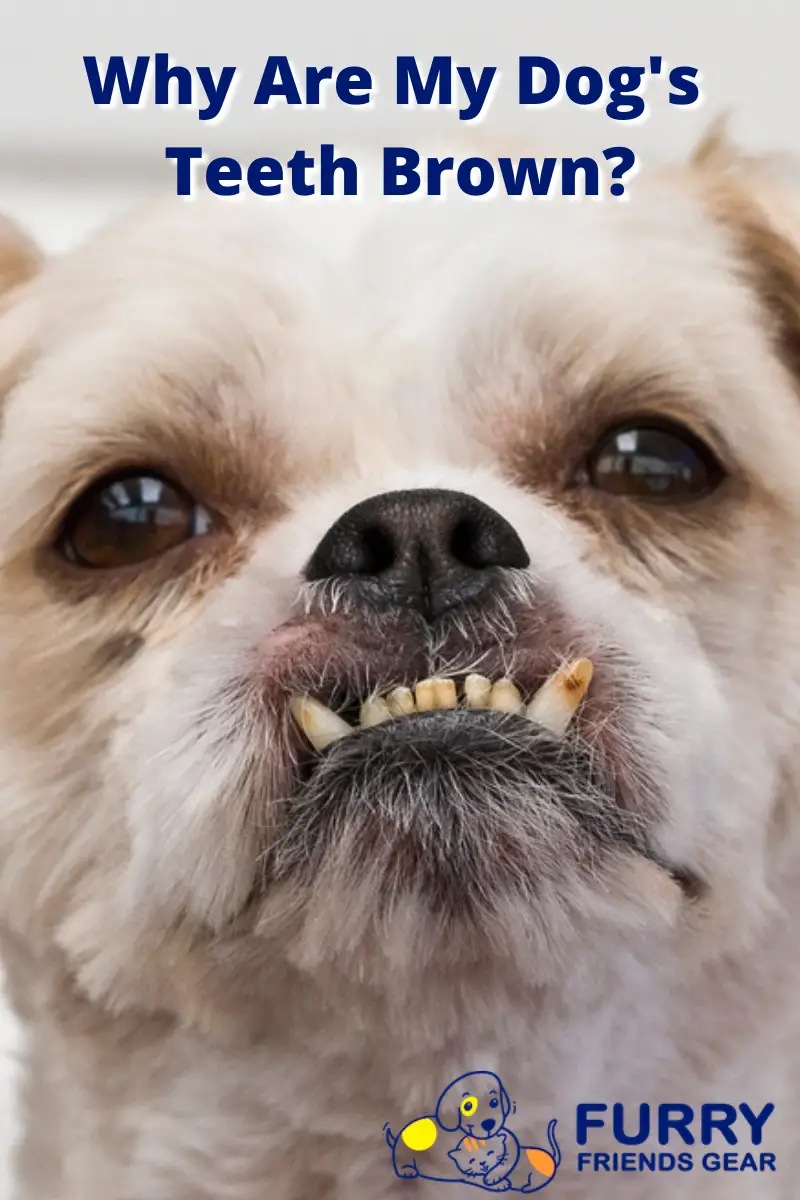The sight of brown color or tint on one of your dog’s teeth may not be a sign of a severe issue, but it is still something that you must address. Tooth discoloration happens in six out of ten dogs, and there are a handful of possible causes. While there’s always the option of taking your pup to the veterinary dentist for a comprehensive examination, not all owners have the time or commitment to do it. But what is the brown stuff on my dog’s teeth?
Even if there’s no need for immediate treatment, it’s your job to consider all the possibilities on why there’s brown stuff on your dog’s teeth. Since it isn’t supposed to be there, it only means that there’s an underlying issue that may affect the animal’s oral and holistic well-being.
It doesn’t take a genius to figure out what might be causing it – all you must do is read this article to learn about the possible causes. We’re confident that you’ll be more convinced to get professional help for your furry buddy after reading this post.
Tooth discoloration is categorized into two: extrinsic and intrinsic.
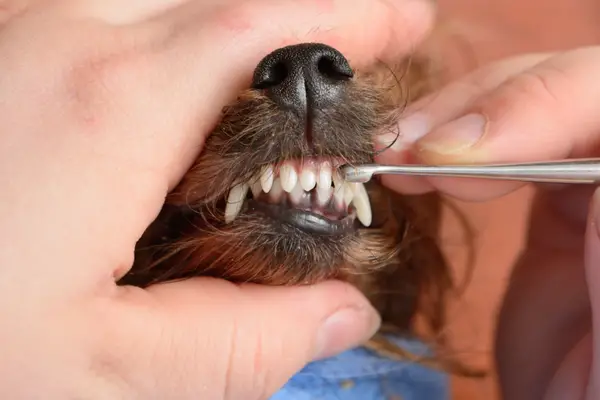
Extrinsic Discoloration
Both brown and yellow teeth characterize extrinsic discoloration. It occurs when stains start building upon the surface of the tooth. The term suggests that the discoloration is caused by an external source instead of an underlying condition or infection. Your dog develops brown and yellow stains in its tooth because of food stains, stains caused by medication, bleeding gums, and the buildup of plaque and tartar. It can also be caused by munching on metal.
Intrinsic Discoloration
Meanwhile, discoloration on your dog’s teeth is described as intrinsic when you see the color black, gray, purple, pink, or blue. As the name suggests, this one happens within the tooth structure and is most likely caused by an underlying health problem. The causes of intrinsic discoloration may be one of the following:
- Presence of excess bilirubin in the blood
- Systemic infection
- Injury to the tooth
- Certain health conditions involving the underdevelopment of the enamel or dentin
Furthermore, intrinsic staining is a telltale sign of dead pulp tissue inside the tooth. Keep in mind that dead pulp tissue usually leads to pain and inflammation right down to the bone surrounding the end of the root. The issue with dead teeth in pets is that it’s almost impossible to notice any outward sign of pain since dogs don’t know how to tell you that it is in discomfort. Dental pain is something that dogs are quite good at masking.
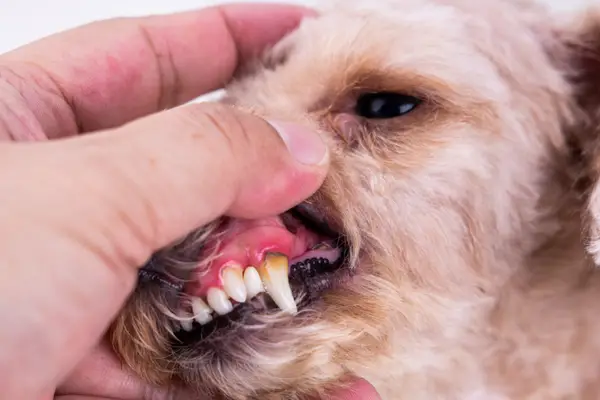
What Is The Brown Stuff On My Dog’s Teeth? Familiarizing the Signs
Both extrinsic and intrinsic tooth discoloration showcase a familiar set of signs, including but not limited to, the following:
- Fractured tooth
- Abnormal color on the crown
- Stained enamel
- Pitted and rough enamel surface
- Lines and rings of discoloration around the teeth
Related article: Best Way To Clean Dog’s Teeth, Insider Pro Tips
How About Rotten Teeth?
There are times when you’re dealing with something more severe than discoloration. Rotten teeth are common in dogs, and the first sign is a stinky mouth. If you don’t have the time to take your pup to a dog dentist, you at least should be able to pinpoint the signs. Being in the “know” means you can measure the severity of the problem and eventually realize if going to a veterinarian or dog dentist takes immediacy.
The warning signs are:
Tartar or Plaque
The buildup of hardened dental plaque may appear harmless, but it’ll wreak havoc on your dog’s oral health once it reaches the inside of the teeth and gums. It’s a mineral deposit that usually appears yellow, brown, or orange.
Holes Created by Cavities
Dental cavities (caries) appear as holes in the teeth. They’re easily identified because of their dark appearance on the surface. It can be dark spots or holes. Cavities, if not addressed right away, could lead to severe tooth pain.
Discoloration
Tooth discoloration is quite common as brown or yellow in appearance. You’ll notice it on your dog’s teeth along the gumline. The discoloration is usually the start of the buildup of plaque and tartar.
Gingivitis
Perhaps you’re surprised by it, but dogs also suffer from gingivitis. You know that your dog has it when the gums are swollen. The gums appear swollen and inflamed, eventually wrapping the teeth. In most instances, the inflamed gums are accompanied by the plaque at the base of the teeth.
Periodontitis
Remember when we talked about gingivitis in dogs? If you continue ignoring the condition, it’ll eventually result in periodontitis, which is a severe type of gum disease that causes the gum line to pull away from the teeth. It’ll form pockets and cause bleeding or produce puss.
Bad Breath
Your dog’s stinky breath may no longer be just about the food it ate. It can be a sign of poor dental hygiene and rotten teeth. If the dog’s breath has the same foul odor regardless of the food you give, it means that a more severe condition causes the bad breath.
It Started with Brown Tooth, and Now It’s Abscess
Don’t wait to find the answer to “what is the brown stuff on my dog’s teeth?” Just when you thought that the brown color on your dog’s teeth was nothing to worry about, you’re now facing the prospect that it might be a tooth abscess. Your biggest issue right now is that you can’t investigate your dog’s mouth because the animal is uncomfortable with it. Fortunately, there are ways to spot the signs without forcing your pet to open its mouth.
Difficulty in Eating
The first sign that the brown teeth have turned for the worse is when the dog finds it difficult to eat or even chew on its favorite treat or toy. It is indicative of tooth pain when the pet hesitates to pick up food or favors one side of the mouth when eating.
Head Shyness
This behavior is highlighted by your dog’s negative response when you try to touch one side of its face or mouth. There comes a time when it no longer allows you to touch its whole head. The reason for this is pain that’s caused by rotten teeth or the development of an abscess.
Drooling
Another sign of teeth abscess or an advanced stage of rotten teeth is when you notice an unusual drool from your pet.
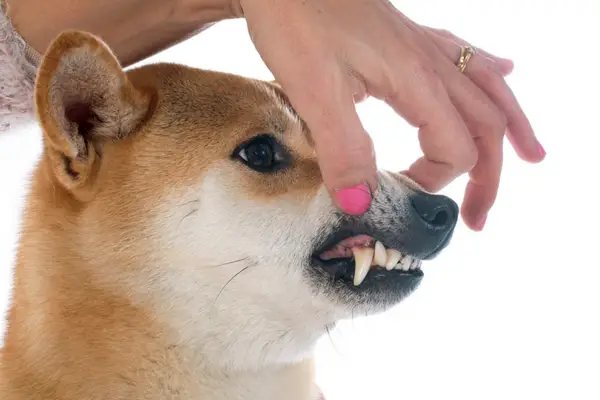
Bloody Saliva
A dog that spits out bloody saliva is a clear indication that it suffers from a severe dental issue. It could be directly caused by rotten teeth or something else.
Frequent Sneezing
When dogs experience severe periodontitis, they will likely suffer from bone loss between the oral and nasal cavities. This bone loss is the reason why you notice that the animal sneezes all the time. The nasal discharge triggers the sneeze.
Presence of Blood in the Dish or Chew Toys
When bloody saliva is excreted, it usually shows up on the chew toy or the water dish. It’s another clear sign of tooth abscess.
Related article: Best Dog Teeth Cleaning Toys, A Comprehensive 2022 List
What If the Brown Tooth Falls Out?
You’re lucky to catch the brown-colored tooth falling out, but that’s highly unlikely. Dog owners don’t usually notice right away that the dog has lost a tooth. There’s a scenario when the dog bleeds from the mouth and transfers it to the water bowl. If you chance upon this situation, take a closer look at the inflamed gums. In cases of severe tooth abscess, parts of the tooth will crack.
A dog’s teeth falling out are attributed to two reasons: first is the tooth’s trauma, second is because of periodontitis. The buildup of plaque and lack of treatment causes the gums to swell, which in turn develops into periodontitis. As it happens, the gums pull away from the teeth, which allows bacteria to creep in. As bacteria eats away at the teeth, it will eventually lead to decay and tooth loss.
What Is The Brown Stuff On My Dog’s Teeth and What Does It Mean?
Brown teeth, or any discoloration for that matter, aren’t the only oral health issue that’s common in dogs. You may also notice brown spots, this time on the gums. A would-be dog owner needs to dig deep and research a specific breed’s tooth and gum patterns. What you consider normal for one breed could be a sign of trouble for another. Nevertheless, the sudden appearance of brown spots on the gums tells you that it is time to visit a veterinarian or a dog dentist. It could be because of the lack of proper hygiene or something more serious.
Possible Infection
Gum infections, i.e., gingivitis and periodontitis, are likely causes of the brown spots on your dog’s gums. Unless you are a veterinarian, there’s no way to figure this out on your own. Hence, the only possible determination is performed by a vet. If for some reason, you can’t take your dog to the doctor at the moment, then you can examine it on your own if you want to.
Look for swelling and redness along the gum lines and near the spots. If you see something together with slight bleeding, then it’s likely an infection. You’ll know that the infection is at an advanced stage when your dog favors chewing on one side of the mouth and avoids the other. It is indicative of a painful infection on the gums.
Natural Pigmentation
As mentioned earlier, it is your responsibility to research the dog that you wish to own regarding patterns and natural colors in their gums and teeth. Normal pigmentation varies from one breed to another. While pink gums are the epitome of a healthy pup, some breeds come with brown spots. So, it’ll be challenging to figure out if your four-legged buddy has gum disease or if it’s a natural color. Arm yourself with information before you panic.
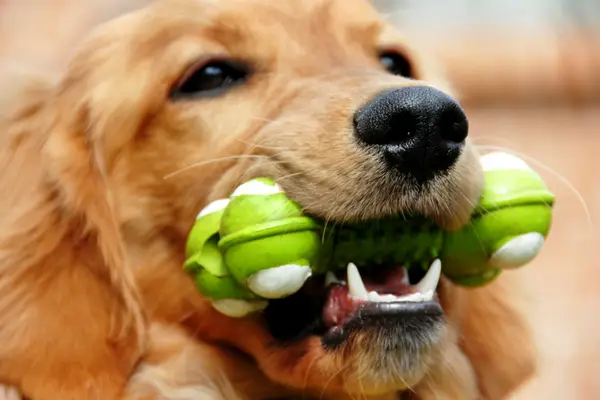
What Happens If Gum Infections Aren’t Treated?
If you fail to spot the infection or you’ve suspected it but didn’t bother having your dog checked, then it’ll naturally spread throughout the body. Keep in mind that gum infections are a prelude to more severe health problems that may result in your dog’s death. That alone should help convince you to have that infection treated.
The best way to avoid a gum infection is on a preventive basis. It means that once you suspect there’s gum disease, then take Fido to the vet right away for a quick treatment. As we talked about earlier, you shouldn’t wait for things to spiral out of control, i.e., teeth start to rot and fall out.
Fortunately, gum disease and infection are avoidable by performing convenient preventive measures. Proper oral hygiene begins with brushing to get rid of plaque and prevent the buildup of tartar. But because it’s no cakewalk to brush your dog’s teeth, you may want to explore the alternatives like giving the animal something that it likes, such as dog treats and chew toys. Both products are effective in removing plaque and massaging the gums.
But once you see plaque from your dog’s teeth, that’s when you must do whatever you can to remove it. Well, it doesn’t mean you do the cleaning with your hands. The most crucial thing is your commitment since you’re likely to dedicate a ton of attention, effort, and time. Dogs aren’t naturally keen on cleaning their teeth, so they need you to do it for them.
Start with a healthy and balanced diet. What your four-legged buddy eats is based on age, preference, and oral health considerations. If you see that your pup is prone to developing plaque, then feeding it with dry food helps since its abrasive texture helps in cleaning the teeth.
If brushing is out of the question, the next best thing is a dog chew toy or treat. Find safe and high-quality toys with small bumps in the design. As your dog fondly chews it, the plaque and buildup of tartar are avoided without you sweating it out.
Now that you know the answer to “What is the brown stuff on my dog’s teeth?”, be sure to clean your pet’s teeth! Also, be sure to spread this information to other dog owners in order to save them a problem in the future.

